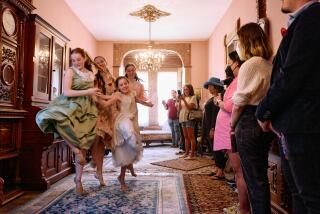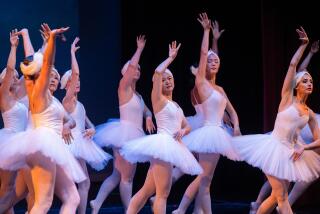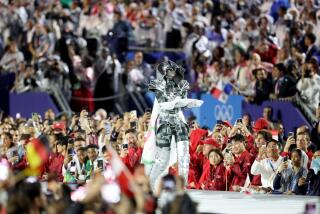The past helps shape his present
- Share via
New York — FOR a choreographer in a country whose dance scene is fiercely focused on the new and experimental, Thierry Malandain is unusually fascinated by the past. The 46-year-old French choreographer seems engaged in an ongoing dialogue with the history of his art.
Malandain’s company, Ballet Biarritz, was last seen by U.S. audiences in 2002 with a program of four titles from the famed Ballets Russes repertory as reimagined in contemporary terms by Malandain. His “Afternoon of a Faun,” although set to the original Debussy score, presented an athletic and eager young man in briefs whose sensual bounding culminated with a dive into a giant tissue box. For “Bolero,” he trapped his dancers within panels until the music’s final climax coincided with their breaking free.
For the program that Ballet Biarritz will bring to the UCLA Live series Friday and Saturday, Malandain has gone much further back in the dance history books. He has turned to two ballet scores from the 18th century that were originally choreographed by groundbreaking dance figures of the day. “Les Petits Riens,” to a Mozart score, was first choreographed by Jean Georges Noverre (1727-1810) in 1778, while Gluck’s 1761 “Don Juan” featured choreography by Gaspero Angiolini (1731-1803). Both works are credited with launching the ballet d’action, in which dance could carry theme and narrative rather than serve as mere decoration. Both Malandain works will receive their U.S. premieres at Royce Hall.
“I love the history of dance, because I perceive that people in earlier times posed the same questions as now,” the lean, intense Malandain said backstage at New York’s Joyce Theater, where Ballet Biarritz performed a different program in February. His longtime associate and company ballet mistress, Francoise Dubuc, translated whenever he shifted from English to French. “I enjoy doing new things, but I also like to revisit and reinterpret pieces that were done before. I enjoy imagining that I am in a conversation with Noverre or Angiolini.”
Reconstruction is not what Malandain is after. And in the case of these nearly 250-year-old ballets, reassembling what was originally onstage was out of the question. But Malandain has clearly steeped himself in their history and significance and has sought to find his own response to their material.
His choreography draws on ballet technique, and the 16 members of his troupe have ballet training. But his vigorous, sometimes quirky movement, as seen in the 2003 “Creation,” which they performed at the Joyce, is clearly in a 21st century vein. The 70-minute ballet set to Beethoven juxtaposes allusions to the biblical Creation with a fast-forward history of dance. Glimpses of Baroque movement, suggestions of “Giselle” and evocations of Loie Fuller and Isadora Duncan pass through, suggesting parallels between mankind’s emergence from Eden and dance’s progression through the stages.
“In France, my work is not ‘modern.’ It’s ‘neoclassic,’ ” he said. “The other choreographers are more ‘modern’ because the movement that is at the forefront is what is called the non-danse. Often, they hire performers who are not dancers.” In this environment, dances that feature narrative or a close adherence to traditional scores are not considered au courant.
Malandain was aware of his outsider status when, as a dancer and budding choreographer with the Ballet de Nancy, in northeastern France, he decided to form his own company in 1986. “We were classical dancers,” he said of his initial troupe. At that time, he noted, French dance was epitomized by choreographer Maguy Marin and other experimental figures. “Choreography must advance,” he agreed. But “for me, it’s a problem of dance but also of politics. For me, the music is very important. I work closely with every score.”
“Politics” is a factor because Ballet Biarritz is a Centre Choregraphique National, or National Choreographic Center -- one of 19 around the country subsidized by the French government. It is in the famed seaside resort community in southwest France, in a Basque area close to the border with Spain. Malandain was invited to direct the center when it was founded in 1998. “My first company was independent,” he said. “This environment is different -- the government support changes everything. As representatives of a cultural policy, the companies at these centers have responsibilities for outreach and other public projects.”
*
Time on the road
A vacation destination in a remote corner of the country is a very different setting from those where the other national companies are based. “In the beginning, it was very difficult, because Biarritz is like Monte Carlo: rich people, and they generally like tutus and pointe shoes. I make classical dance, but not with tutus and pointe shoes,” Malandain said.
And the government subsidy does not mean the companies are home free. Although the 50% of the Ballet Biarritz budget covered by subsidy would be considered lavish by U.S. standards, the troupe still has to earn the other 50%. Since its home base is one of the smallest of the Centres Choregraphiques, Ballet Biarritz spends a lot of time on the road, currently touring with four programs. It even does a “Nutcracker” -- a compact, offbeat production Malandain created in 1997 -- that generates annual bookings from Belgium to Spain.
The connection to Spain is a strong one, with the troupe maintaining a junior company in nearby San Sebastian, just 20 minutes from Biarritz. “We perform each of our programs there, and we do outreach to younger people and many public rehearsals,” Malandain noted.
He was looking forward to getting back to rehearsals for “Don Juan” once the company returned from New York, in preparation for its Feb. 25 premiere. (“Les Petits Riens” had its premiere in October.) Because of the touring schedule, he had to create the 40-minute work over a period of months.
“Gluck’s score is quite astonishing, because it’s the first real ballet in history, with the composer writing a score for the story,” Malandain observed, adding that Gluck and choreographer Angiolini drew on Moliere’s version of the legendary libertine. “ ‘Don Juan’ is eternal -- a ballet about love, betrayal and death. I focus on three characters: Elvire, Don Juan and the Commander. Everyone in the company, men and women, portrays Elvire” -- whom the title character has seduced and abandoned. “There are three different Don Juans.” In “Creation,” he also had multiple dancers share roles, bringing on a different Adam and Eve each time the couple returned for a duet. It’s an approach he favors, he said, because “for me, every human being is a little bit of everything. Each one of us has many faces.”
“Don Juan” is one of Malandain’s more theatrical works. “The set for this production is a large table composed of many triangles,” he said. “When Don Juan makes another conquest, segments are taken away.” In contrast to its deeper themes, “Les Petits Riens” is a lighthearted curtain-raiser that he sums up with the French term plaisanterie.
“The ballet has the reputation of being impossible to remount because the score was lost for 100 years and then discovered in disorder. We don’t know the original order of the sections,” he said. Choreographers have sometimes set abstract ballets to the jaunty Mozart music, but Malandain’s approach relates to the original scenario, which involves Cupid, shepherdesses and birds. He added sheep to his version, which shows dancers preparing to present the ballet. “The dancers are not performing the story. We see anecdotes from the ballet. It is only at the end, when the curtain falls, that ‘Les Petits Riens’ is actually about to start.”
In his program notes, Malandain says the process behind these two dances -- what he calls “rereading a choreographic work” -- “means learning to know it, to be interested in the historical and social context of its creation, and then to have enough imagination to look at it in a different way.”
Others, in short, may focus on the divisions between what is “classical” and what is “contemporary.” Malandain draws inspiration from what unites them.
*
Ballet Biarritz
Where: Royce Hall, UCLA
When: 8 p.m. Friday and Saturday
Price: $28 to $50
Contact: (310) 825-2101
or www.uclalive.org
More to Read
The biggest entertainment stories
Get our big stories about Hollywood, film, television, music, arts, culture and more right in your inbox as soon as they publish.
You may occasionally receive promotional content from the Los Angeles Times.










